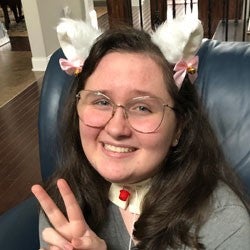Hydrocephalus
Life was normal for Sophia McHugh when she went to bed on January 11, 2021. But everything quickly changed just a few hours later. The next morning—completely out of the blue—she began experiencing nausea, vomiting, and a headache. “At first we thought it was just a stomach bug,” says her mother, Viktoria. “But the vomiting began happening so frequently, we knew something was not right.”
Viktoria and her husband, Mike, rushed Sophia to the local emergency room in Huntsville, where everything quickly went downhill: Sophia experienced a seizure and had to be intubated. In the meantime, all tests kept coming back negative before an MRI revealed hydrocephalus, which is an abnormal buildup of fluid in the ventricles deep in the brain. Within just a few hours of being admitted into the emergency room, Sophia was being prepped for brain surgery. “Her brain had so much swelling there was really no choice,” Viktoria explains. “There was too much pressure on her brain.”
An external shunt was successfully placed to allow the fluid to drain, and as soon as she was stable, doctors knew she needed to be transferred to a pediatric hospital. “Our local hospital had her stabilized, but they couldn’t accommodate all she needed,” Viktoria explains. “We chose to transfer to Children’s of Alabama.”
Sophia arrived at Children’s in the early hours the next day, stable but critical, and in an induced coma. She was quickly admitted to the ICU, where—despite previous tests in Huntsville coming back negative—she tested positive for COVID-19. “We’re so thankful that Children’s let us stay in her room and quarantine with her,” Viktoria adds. “We couldn’t imagine not being there with her because for her body, that was like the perfect storm.”
Already weak from the hydrocephalus, Sophia’s body began failing after the diagnosis of COVID-19. Her fever couldn’t be contained and her lungs were failing, and then a few days later, she went into heart failure. At that point, she had to be placed on Extracorporeal Membrane Oxygenation (ECMO), a heart-lung bypass machine, to try to give her heart and lungs time to heal. “She was on ECMO for three days, and then they were able to take her off,” Viktoria says. “They then gave her five treatments of plasmapheresis, which led to great improvement.”
That improvement, however, was set back as doctors discovered Sophia had been experiencing multiple small strokes. Those strokes led to nerve damage and paralysis of the majority of her body. She also experienced muscle myopathy. “She continued to endure so much, including a second brain surgery to remove the external shunt and create a hole between two ventricles to allow fluid to drain,” Viktoria says. “But she continued to slowly improve.”
Sophia also continued to undergo physical therapy. Physical therapists worked with her every day, including using the TruRize chair, to help her regain mobility. After three weeks in the ICU and months in the hospital, she was able to go home to see her brother, Patrik, and sister, Lauren, who she hadn’t seen since her hospitalization began. “Sophia still uses crutches and experiences some trouble with her balance, but the hope is that she will fully recover,” Viktoria says. “I can’t say enough about Children’s. The doctors and nurses were so attentive and always made sure we had all of the information we needed. Going through all she did, we’re so grateful that Sophia had Children’s.”







